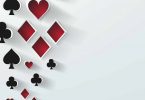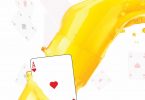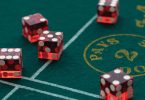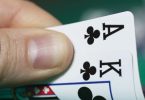Welcome to the conclusion of our exposé on the mysterious art of following baccarat trends. Part 1 was the cover feature of our February issue of WGM and reading Part 1 will give you a better understanding of Part 2. If you don’t have a copy of our last issue, you can read Part 1 (and every other article ever published in WGM) on our website at wgm8.com.
In Part 2 we will explain the color rules, the prediction table and how players interpret the roads to determine what to bet on each hand and how much to bet.
The color rules for derived roads
Big Eye Boy, the Small Road and the Cockroach Road each show alternating streaks of red and blue, with a new symbol added to each derived road after each hand once the road has started. But how is the color of the symbol determined?
This is very interesting and quite complex. The best way to understand is to consider Big Eye Boy first. Once you understand Big Eye Boy, it’s quite easy to understand the Small Road and the Cockroach Road as they require only a minor adjustment. So let’s focus on Big Eye Boy.
The rule for adding a symbol to Big Eye Boy is different, depending on whether:
- The hand just played was entered in the first row in the Big Road, in other words it is the first hand of a new streak (we call this a “streak starter”), or
- The hand just played was entered in the second or subsequent row in the Big Road, in other words it is not the first hand of a new streak (we call this a “streak continuer”).
Streak continuers are easier to understand than streak starters, so let’s consider them first. There are three possible cases for streak continuers:
- The cell on the left of the streak continuer (in the Big Road) is full, which in Chinese is called 拍拍连, literally meaning “clap clap connect.” In other words, the streak continuer is “connected” to the cell on its left.
- The cell on the left of the streak continuer (in the Big Road) is empty, but the cell above that empty cell is full (in other words the streak continuer has now made the current streak precisely one hand longer than the previous streak). In Chinese this is called 一厅两房, which means “one lounge two bedrooms.” The term is logical: if you look at the four big road cells formed by a square, with the streak continuer in the bottom right corner of that square, there will be one circle of one color in the top left position (“one lounge”), and two circles of the other color in the two right positions (“two bedrooms”).
- The cell on the left of the streak continuer (in the Big Road) is empty, and the cell above that empty cell is also empty. This means the current streak is now at least two hands longer than the previous streak. In Chinese this is called 长庄 or 长闲, which means long banker or long player (depending on whether the current streak is banker or player). It doesn’t matter whether the streak is banker or player, the key factor is that it is long.
The color rules simply state that for streak continuers (in the Big Road), the result of the next symbol in Big Eye Boy is red for “connected” and “long”, and blue for “one lounge, two bedrooms.” See the image below.

Note the colors of the circles in the Big Road are irrelevant, which is why they are shown in black instead of the usual red and blue.
Now you know the color rule for streak continuers, you can learn the color rule for streak starters. The color to be added to Big Eye Boy after a streak starter is simply the opposite color to the one that would have been added had the previous streak continued. See the examples on the right hand page.

What about the situation when a streak starter immediately follows another streak starter? This is a ping pong situation. The color of the symbol to be added to Big Eye Boy for the first two symbols of the ping pong could be red or blue depending on the length of the two prior streaks, but once we get to the third hand and onwards in the ping pong, the symbol added to Big Eye Boy must be red. As long as the shoe continues to ping pong, Big Eye Boy will continue to be filled with a streak of red symbols. Given the color rules explained above, you should be able to prove this ping pong result to yourself (hint: the answer is in the middle figure on the left).
Now you understand the color rules for adding symbols to Big Eye Boy, it is easy to understand the color rules for adding symbols to the Small Road and the Cockroach Road. They are identical to the rules for Big Eye Boy, with one fundamental difference. Under Big Eye Boy, we always compared to the previous column to determine the color of the next symbol. With the Small Road, we compare not to the previous column, but to the column before that. With the Cockroach Road, we compare to the column yet another column back. So Big Eye Boy looks one column back, the Small Road looks two columns back, and the Cockroach Road looks three columns back.
The prediction table
Turn over to the next page and take a look at the large figure. At the very right there is a small table, pictured here on the right, with the three blue and three red symbols. We call it the “prediction table.” Notice it has a red 庄 Chinese character (representing banker) and a blue 闲 Chinese character (representing player) at the heading of the columns. Under those characters are blue and red hollow circles (for Big Eye Boy), solid circles (for the Small Road), and slashes (for the Cockroach Road).

The purpose of this table is to show what color the next symbol in each of the three derived roads will be, given the result (banker or player) of the next hand. Note if the color for the next symbol given a banker win is blue, then the color for the next symbol given a player win must be red, and vice versa. Players can look at the trends in one or more of the derived roads, make a decision about which color they feel will next occur in any particular derived road and the prediction table tells them which side (banker or player) must win on the next hand to make that color the one to be added to that particular derived road.
If any cell in the prediction table is blank, it means that particular derived road has not yet started and will not start on the next hand. Remember the earliest hand Big Eye Boy can start is the third hand, the earliest hand Small Road can start is the fourth hand and the earliest hand Cockroach Road can start is the fifth hand, and if there are long streaks very early in the shoe the predictive roads may not start until considerably later.
Interpreting the roads
Having described how all five roads are created, how do baccarat players use them to determine their bets? There are as many different answers to that question as there are players, but some common themes exist in interpreting the roads and making betting decisions based on those interpretations. This is why you often see many players crowded around a baccarat table, betting on the same side (banker or player).
In the Big Road and Bead Plate, players tend to look for patterns and symmetry.
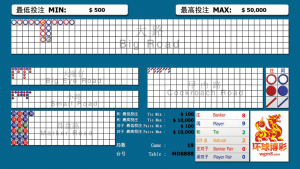
Look at the above figure. On the next hand players might choose to bet banker which would make the Big Road perfectly symmetrical. Also note a pattern in the Bead Plate: the second last row is all blue. When the hand comes for the next column in that row players may bet on player, anticipating another blue symbol in that row. A player might also place a tie bet on the upcoming hand, anticipating a green symbol in the Bead Plate continuing the short line of green symbols already in the Bead Plate.
The derived roads are different. The general concept of these roads is that a lot of red indicates regularity in the Big Road, which gives it a feeling of predictability. For example, when there is a long streak in the big road (say a long dragon or alternatively a long streak of ping pong), all derived roads will show many red symbols.
If the Big Road is showing a regular repeating pattern, there will be red in one or more of the derived roads. If the repeating pattern is column-to-column, the red streak will appear in Big Eye Boy. If the repeating pattern is column-to-two-columnsback, the red streak will appear in the Small Road. If the repeating pattern is column-to-three-columns-back, the red streak will appear in the Cockroach Road.
As a general concept, many red symbols in Big Eye Boy, the Small Road or the Cockroach Road indicates a somewhat consistent Big Road.
Sometimes there are multiple repeating patterns in more than one derived road. Players often perceive these situations as particularly powerful, tending to bet more on a consistently repeating pattern that arises in all three derived roads than they would if the pattern is in only one or two of the derived roads. For example if the big road keeps going ping pong or a dragon, all three derived roads will show a lot of red and this could encourage players to bet heavily on the very clear pattern.
The opposite of this is the appearance of a lot of blue, which indicates “choppiness.” But consistent choppiness itself is a pattern that players may latch onto.

Players are also likely to place more faith in betting decisions where all three symbols (hollow circle, solid circle and the slash) are the same color in each column of the prediction box, and that color feels a likely result for the next symbol on each of the three derived roads. This feeling will usually come from some kind of pattern in the derived roads. For example, the above figure clearly dictates a bet next hand on player.
Baccarat trend following and the derived roads Big Eye Boy, the Small Road and the Cockroach Road have been around for decades and there is no sign of them fading away. Originally a Macau phenomenon, they are spreading across Asia and the world. The next time you play and see those red and blue trails of symbols on the display, they won’t be such a mystery. Good luck at the tables!


